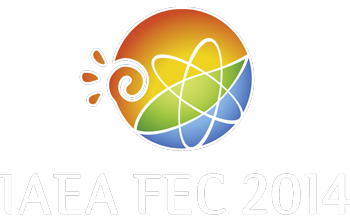Speaker
Dr
Carlos Paz-Soldan
(Oak Ridge Institute for Science Education)
Description
Experiments at DIII-D have demonstrated that several key 3D field sensitivities are directly related to their coupling to the least-stable kink mode of the plasma, and concomitantly that the plasma is remarkably insensitive to fields which have no net coupling to this single dominant (kink) mode. Specifically, plasma rotation and error field (EF) penetration thresholds are nearly unchanged despite application of large amplitude probing fields with no kink coupling. The plasma sensitivity to 3D fields which have no kink coupling is of critical importance as this sets the true geometric tolerance of the tokamak – so long as it is equipped with at least a single row of EF correction coils (EFCCs) and its 3D field sources are well characterized, thus allowing the kink-coupling of the intrinsic EF to be nulled by the EFCCs. The observed weak sensitivity to the no kink coupling field challenges the stringent tolerance requirements currently enforced, as a strong performance recovery when using EFCCs is expected though it is not presently taken into account. The validity of the single dominant mode picture is determined experimentally by contrasting the plasma sensitivity to large-amplitude probing fields that have varying levels of coupling to the kink mode. Sensitivity to rotation braking is contrasted in both H- and L-mode plasmas, where for both scenarios, braking by n=1 probing fields is reduced by nearly a factor of ten when the kink mode coupling is nulled. EF penetration is also contrasted with both H-mode and Ohmic plasmas. In both cases the penetration threshold is nearly unchanged (vs a no-field baseline) when the probing field has no kink coupling, despite its large amplitude. The maintenance of the edge rotation due to the neoclassical toroidal viscosity (NTV) with n=2 fields is also largest when coupling to the kink is maximized. A validated single dominant mode picture can also be applied to predicting optimal EFCC currents for any plasma scenario regardless of 3D field source. This is achieved by nulling the kink mode coupling of the intrinsic EF. Recent work shows that an exhaustive database of over 20 experimentally determined n=1 optimal EFCC currents is consistent with nulling the n=1 kink coupling of each plasma.
This work was supported by the US DOE under DE-AC05-06OR23100, DE-FC02-04ER54698, DE-AC02-09CH11466, and DE-FG02-04ER54761.
| Country or International Organisation | USA |
|---|---|
| Paper Number | EX/P2-28 |
Author
Dr
Carlos Paz-Soldan
(Oak Ridge Institute for Science Education)
Co-authors
Mr
A. M. Garofalo
(General Atomics)
Dr
Benjamin J. Tobias
(Princeton Plasma Physics Laboratory)
Dr
Daisuke Shiraki
(Oak Ridge National Laboratory)
Dr
Edward J. Strait
(General Atomics)
Dr
Jeremy Hanson
(Columbia University)
Dr
John S deGrassie
(General Atomics)
Dr
Jong-Kyu Park
(Princeton Plasma Physics Laboratory)
Dr
Josh D King
(Oak Ridge Institute for Science and Education)
Dr
Keith H. Burrell
(General Atomics)
Dr
Matthew Lanctot
(General Atomics)
Dr
Nathaniel M. Ferraro
(General Atomics)
Dr
Nikolas Logan
(Princeton Plasma Physics Laboratory)
Dr
Richard J. Buttery
(General Atomics)
Dr
Rob La Haye
(General Atomics)
Dr
Wayne M. Solomon
(Princeton Plasma Physics Laboratory)

